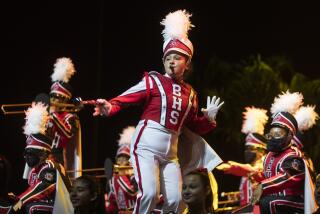UNITY KEY TO FUNDS, GROUPS TOLD
- Share via
PACIFIC GROVE, Calif. — Minority, or multicultural, California arts groups must band together to get their fair share of public and private funding, the chairwoman of the Assembly Ways and Means Committee said here over the weekend.
In a keynote speech to the opening session of California Dialogue, the first statewide conference for representatives of multicultural arts organizations, Assemblywoman Maxine Waters (D-Los Angeles) addressed the issue of imbalance in the funding of minority arts organizations compared to their population percentage.
“The theme here this weekend is empowerment through unity,” she told the 120 representatives of multicultural arts groups attending the three-day gathering in the idyllic seaside Asilomar State Beach Conference Center.
“I want you to create and to help others to create and to build networks and provide access and do all those kinds of things,” she said. “But to do that, we must hang together, we must stay together, we must respect each other and come away from here with a new beginning and a new thrust, getting into the world not only of arts and creativity in a new way, but really beginning to look at the funding opportunities in a new way.”
The timeliness of her speech was underscored by the impending hearings in six to eight weeks before her Ways and Means Committee on the proposed fiscal 1986-87 California Arts Council budget.
The driving force behind the establishment of the Multicultural Advisory Panel to the CAC urged those attending--all from groups that have applied to the Arts Council for grants in the last two years--not to become isolationist “artistes” who must “go away and create.”
“You know you can be a better recluse if you’ve got a little money to do it with,” she quipped Sunday.
Reinforcing the unity theme at the conference sponsored by the multicultural panel was Barbara Nicholson, chairman of the Assn. of American Cultures, the national counterpart to the California Dialogue.
“We can make harmonious music if we heed each other’s voices, or we can produce a dissonance that ends up making us not part of the solution, but part of the problem,” said Nicholson, after whose Washington-based organization the California Dialogue was modeled. “As we proceed with the business of this gathering and beyond, let us go about it with the conviction that what brings us together is much more important than where we differ.”
Others attending the conference seemed to be thinking along those same lines.
“Our goal is to speak with one voice,” said Mary Jane Hewitt, vice chair of the 10-month-old policy-making/watchdog advisory panel to the CAC and co-director of the Museum of African American Art.
“We will get strength at the conference from seeing each other surviving, and we can overcome provincialism by meeting multicultural arts representatives from across the state,” said Gema Sandoval, co-director of the Floricanto Dance Theatre, who is also on the multicultural panel.
The balance of the gathering, which ends this afternoon, will focus on workshops and seminars designed to teach multicultural groups how to continue to survive financially.
The California Arts Council’s $12.6-million budget, from which multicultural programs are earmarked for $164,000, may be raised only by 1% during the 1986-87 fiscal year. If President Reagan’s 1986-87 budget proposal goes through, federal funds to the California Arts Council may be cut back by as much as $200,000, Arts CouncilDirector Robert Reid said Sunday.
After dinner on Sunday, conference participants got to see what all the pleas for unity were really about as artists from across the state presented a mixed-bag performance showcase. Suddenly the creativity they had come to find financial support for came to life, as Day One of the California Dialogue came to an end amid loud applause.
More to Read
The biggest entertainment stories
Get our big stories about Hollywood, film, television, music, arts, culture and more right in your inbox as soon as they publish.
You may occasionally receive promotional content from the Los Angeles Times.










